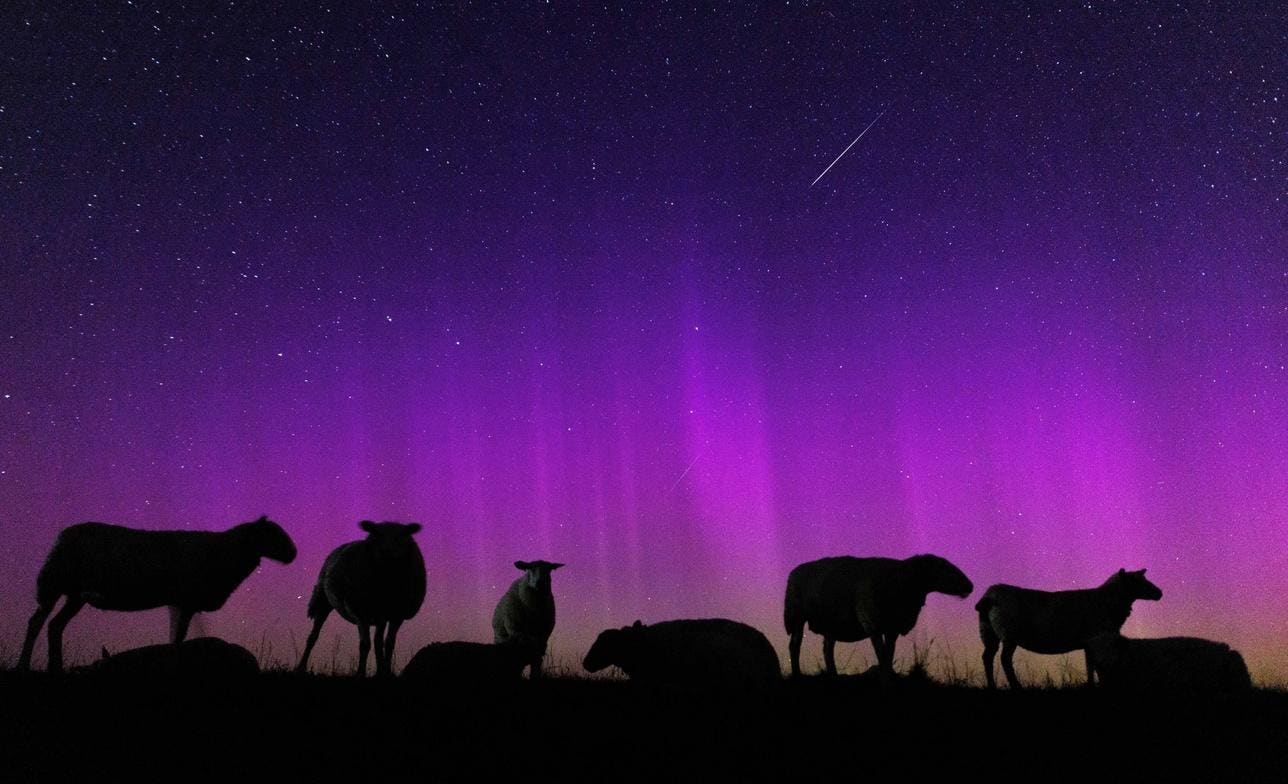Topline
The Orionid meteor shower is set to impress skywatchers overnight on Monday, Oct. 20 through Tuesday, Oct. 21, through. With a new moon on Oct. 21, the night sky will be completely free of moonlight, offering some of the best viewing conditions in years — though viewing under dark, rural skies is recommended. That goes double this year because Comet Lemmon (C/2025 A6) and Comet SWAN (C/2025 R2) — may be visible, and a display of Northern Lights for northern U.S. states is also a possibility.
Sheep under flickering northern lights (aurora borealis) on the dyke to the North Sea near Hagermarsch (Lower Saxony) in East Frisia on 13.08.2024. (Photo by Matthias Balk/picture alliance via Getty Images)
dpa/picture alliance via Getty Images
Key Facts
The Orionids are caused by dust and debris shed by Halley’s Comet, which orbits the sun every 76 years. The comet itself won’t return until 2061.
Earth crosses Halley’s dusty trail each October, with dozens of bright meteors resulting from particles slamming into the atmosphere at high speed. Observers under clear, dark rural skies can expect around 20 meteors per hour during the peak.
The meteors will appear to radiate from the constellation Orion, near the brilliant red star Betelgeuse, but can streak across any part of the sky. Orion rises in the east by late evening and climbs highest around 2 a.m., making the early morning hours ideal for viewing.
Comets Lemmon (C/2025 A6) and SWAN (C/2025 R2) are currently visible in binoculars in the northwest and southwest evening sky, respectively, after dark, as a prelude to the meteor shower.
There’s also a high chance of Northern Lights after dark in northern U.S. states after high solar activity during the past week.
Will Two Comets Be Visible?
This year’s peak may come with a rare bonus, with comets Lemmon and SWAN best seen during a 30-minute window beginning about 90 minutes after sunset. If they brightens enough, they could be visible to the naked eye from dark rural skies, though more likely in binoculars. The comets’ positions in the night sky will change significantly from night to night, so check my feed every day for a daily “comet tracker” with finder charts and tips for viewing from mid-northern latitudes.
How To Watch A Meteor Shower
You don’t need anything except your naked eyes to watch a meteor shower. In fact, if you do have binoculars or a telescope, use them only for the comets because it will only restrict your vision and make it near-impossible to see any meteors. For meteors, the darker the sky, the better. Head at least 20 to 30 miles from city limits to escape light pollution, according to NASA, and give your eyes 20–30 minutes to adjust to the dark. Orion will rise after midnight, with the early hours of Oct. 22 likely to see the most “shooting stars.”
High Chance Of Northern Lights
There’s a good chance that Northern Lights will be visible in northern U.S. states and Canada on Monday, Oct. 20. Geomagnetic activity has been high for several nights after two coronal mass ejections traveled towards Earth from the sun’s surface. Watch NOAA’s latest aurora viewlines for where the Northern Lights may be visible in the northern sky, with likely states including Alaska and (northerly parts of) Washington, Idaho, Montana, Wyoming, North Dakota, South Dakota, Minnesota, Wisconsin, Michigan, New York and Maine.
Check my feed every day this month for a daily “comet tracker” with finder charts and tips for viewing Comet Lemmon and Comet SWAN from mid-northern latitudes. Also read How To Photograph The Green Comets, Best Stargazing Apps For Finding The Comets and 25 Dark Sky Parks In The U.S. To See The Comets.
Further Reading
First Appeared on
Source link













